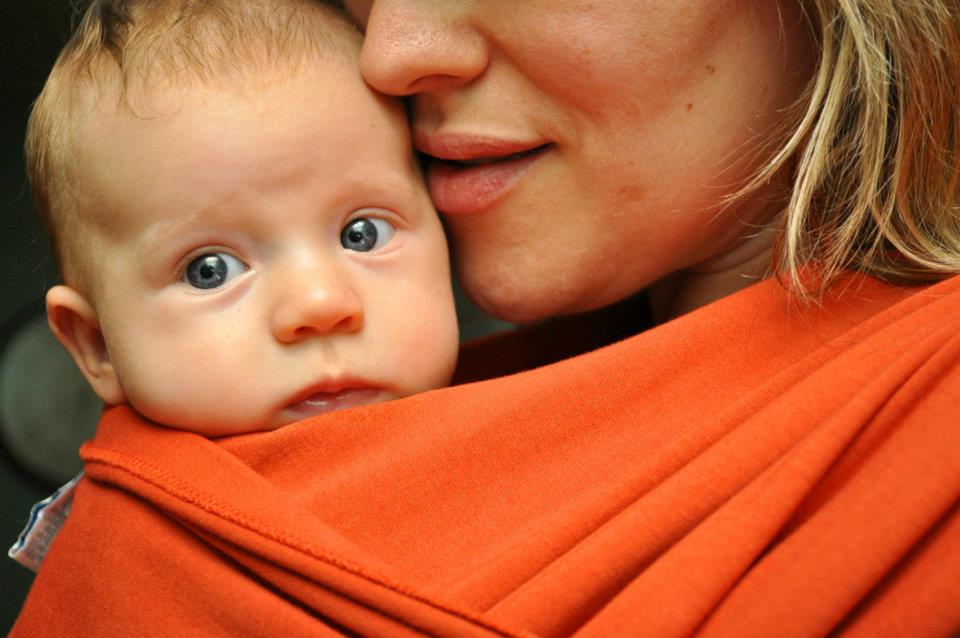 Every morning, as I’m in the bathroom getting ready for work, my husband goes and collects our five-month-old daughter from the bedroom as soon as he hears the half-hearted fussing indicating she’s woken up. It’s become our routine that he brings her out to say good morning to me, her face still bearing the vestiges of sleep, her eyes squinting into the light. Shielding her eyes with his hand, he’ll say brightly, “Here’s Mama!” and I stop whatever I’m doing to give her a huge smile, grab and kiss her pajama-clad feet and welcome her enthusiastically into the new day (even if I’m a bit bleary-eyed and not feeling all that enthusiastic myself). Invariably, she rewards me with a huge, face-scrunching grin, wrinkling her nose and opening her mouth wide — as close as she can get at this point to a reciprocal “Good morning, Mama!” We trade big smiles back and forth for a few moments, and then Daddy takes her in for the much-needed diaper change.
Every morning, as I’m in the bathroom getting ready for work, my husband goes and collects our five-month-old daughter from the bedroom as soon as he hears the half-hearted fussing indicating she’s woken up. It’s become our routine that he brings her out to say good morning to me, her face still bearing the vestiges of sleep, her eyes squinting into the light. Shielding her eyes with his hand, he’ll say brightly, “Here’s Mama!” and I stop whatever I’m doing to give her a huge smile, grab and kiss her pajama-clad feet and welcome her enthusiastically into the new day (even if I’m a bit bleary-eyed and not feeling all that enthusiastic myself). Invariably, she rewards me with a huge, face-scrunching grin, wrinkling her nose and opening her mouth wide — as close as she can get at this point to a reciprocal “Good morning, Mama!” We trade big smiles back and forth for a few moments, and then Daddy takes her in for the much-needed diaper change.
Little did I know, the smiles my daughter and I share with each other are more than just a feel-good social interaction. Researchers at Bar-Ilan University in Israel have found those morning moments I cherish so much are actually tuning our heartbeats to quietly synchronize within milliseconds of the first shared grin, and providing inputs that may shape my daughter’s physical and social development and health for years to come.
It’s an incredibly cool manifestation of a concept called “parent-infant synchrony” which describes the overarching process, applicable to all mammals in the first few months of life, that coordinates exchanges of stimuli between parent and infant during social contact, providing critical growth and development inputs for the baby. This synchrony tunes the mother’s physiological systems to those of her child’s, organizing the baby’s growth, shaping structures in the brain that regulate the stress response, setting the biological clock and regulating heart rhythms. Previous studies in animals have shown that social interactions between mothers and offspring (termed “attachment partners”) have physiological effects on the young, but this study, published in Infant Behavior and Development, is the first to show that the effect extends to humans.
Mothers and their 3-month old infants were observed during face-to-face interactions while cardiac output was collected from mother and child. Micro-analysis of the partners’ behavior marked episodes of gaze, affect, and vocal synchrony. Time-series analysis showed that mother and infant coordinate heart rhythms within lags of less than 1 s. Bootstrapping analysis indicated that the concordance between maternal and infant biological rhythms increased significantly during episodes of affect and vocal synchrony compared to non-synchronous moments. Humans, like other mammals, can impact the physiological processes of the attachment partner through the coordination of visuo-affective social signals.
While the study confirmed that the previously documented mechanisms of human mother-infant synchrony matches with that of other mammals, there’s one important difference: while animal attachment partners require physical proximity and touch for this mutual tuning, only in humans can this effect also be noted after solely non-tactile social interaction via facial and vocal signals, like smiling and cooing. It’s yet to be determined whether the same effect can be observed between infants and fathers, or other caregivers.
So, why care about this? Well, for me, besides the serious warm-fuzzies I get thinking about my daughter’s heartbeat synching with mine within moments of us grinning at each other, these “bio-behavioral exchanges” may be providing critical inputs for my daughter’s physical growth, fine tuning of her biological clock and circadian rhythms, social adaptation and, further down the road, the ability for her to form optimal attachment to my future grandchildren.
But, I gotta confess, all the cool science aside, it’s mostly the warm-fuzzies. Now, if you’ll excuse me, I’m going to go smile at my little girl.
References
 Feldman R, Magori-Cohen R, Galili G, Singer M, & Louzoun Y (2011). Mother and infant coordinate heart rhythms through episodes of interaction synchrony. Infant behavior & development, 34 (4), 569-77 PMID: 21767879
Feldman R, Magori-Cohen R, Galili G, Singer M, & Louzoun Y (2011). Mother and infant coordinate heart rhythms through episodes of interaction synchrony. Infant behavior & development, 34 (4), 569-77 PMID: 21767879
Caroline Sober
Latest posts by Caroline Sober (see all)
- “Baby, you have the dreamiest antibodies…” - February 24, 2012
- With Just a Smile, Our Hearts Beat as One - December 28, 2011
- DIY: Build a Baby Who Loves Broccoli - March 28, 2011

Such a sweet post Caroline. Perhaps the research is validating what mother’s have known all along!